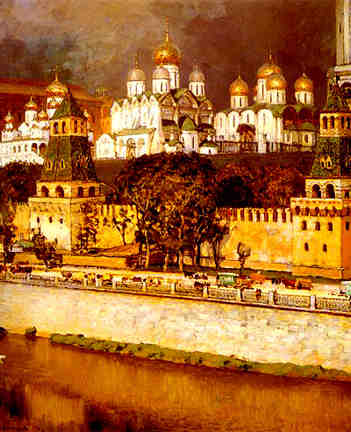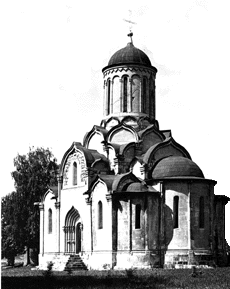The OPRICHNINA
 In December 1564, in a dramatic move, the tsar, accompanied by his family and members of his household, left Moscow, ostensibly never to return. The royal caravan, however, did not travel far and settled down in the nearby Aleksandrovskaia Sloboda, which was to serve as Ivan's official residence until the end of his reign. Shortly thereafter Ivan, in messages to the Muscovites, announced his intention to abdicate. He bitterly attacked the boyars and the clergy, whose failings had allegedly forced him to renounce his royal status, but he exonerated the merchants, artisans, and the common people from all responsibility.
In December 1564, in a dramatic move, the tsar, accompanied by his family and members of his household, left Moscow, ostensibly never to return. The royal caravan, however, did not travel far and settled down in the nearby Aleksandrovskaia Sloboda, which was to serve as Ivan's official residence until the end of his reign. Shortly thereafter Ivan, in messages to the Muscovites, announced his intention to abdicate. He bitterly attacked the boyars and the clergy, whose failings had allegedly forced him to renounce his royal status, but he exonerated the merchants, artisans, and the common people from all responsibility.
The not-unexpected result of this curious maneuver was the prayerful request of the Muscovites to Ivan to reconsider his decision and to resume his duties on his own terms. This he agreed to do; the price was a large indemnity to defray the cost of the royal flight, the surrender and execution of the leading boyars, and the creation of the oprichnina, a royal domain directly controlled by the tsar.
An ancient term, oprichnina signifies an entailed domain and was used to describe the estate settled on the widow of a sovereign prince. The choice of the term was presumably Ivan's own; he liked to think of himself as an orphan or a widower. Under the new dispensation the territory of the nation was split into two parts: zemshchina and oprichnina. The former was administered by the traditional institutions, from the boyar duma down; oprichnina, the personal domain of the tsar, had its own administrative agencies independent of those of the zemshchina.
Oprichnina presumably had two main objectives: the first, of a passing nature, was the extermination of treason; and the second, of lasting significance, was the elimination of the political influence of the landed aristocracy. In pursuit of the former goal the oprichniki were actually agents of the security police. This function was emphasized by their appearance; the emblem of their authority was a broom and a dog's head attached to their saddles. The second objective--the destruction of the influence of the landed aristocracy--was achieved by a mass transfer of the population , a familiar policy used extensively by Vasili II, Ivan III and Vasili III. The territories assigned to oprichnina, including streets in Moscow and other urban centers, were cleared of property owners and occupants and settled by the oprichniki. The dispossessed owners, among then many boyars and former princes, were given estates in service tenure elsewhere, preferably in distant border regions. There was nothing new in this policy except the scale on which it was implemented. The resulting elimination of the influence of the landed aristocracy and the mass transfer of land were the chief political, economic and social consequences of the oprichnina.


|




